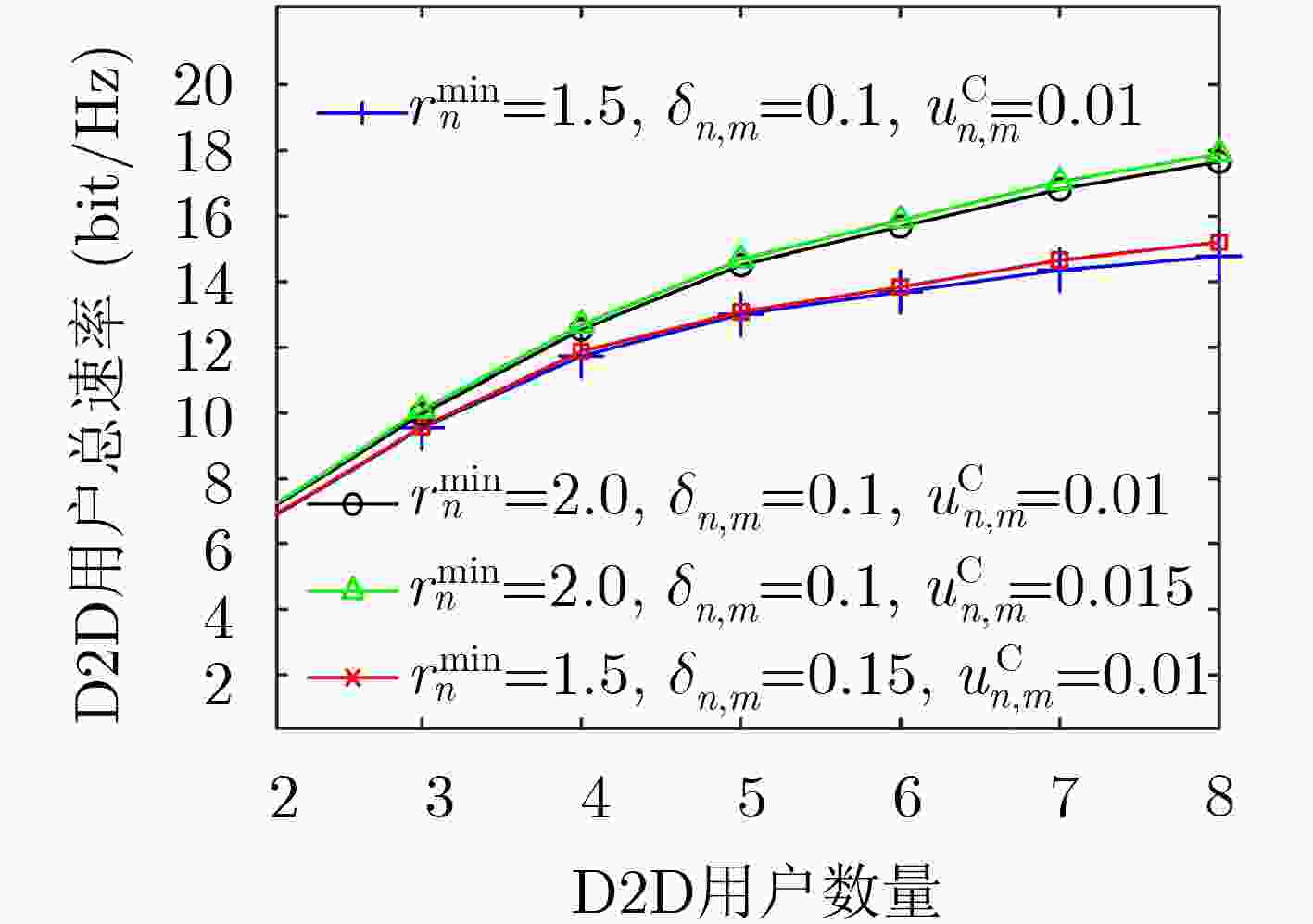| [1] |
WAQAS M, NIU Yong, LI Yong, et al. A comprehensive survey on mobility-aware D2D communications: Principles, practice and challenges[J]. IEEE Communications Surveys & Tutorials, 2020, 22(3): 1863–1886. doi: 10.1109/COMST.2019.2923708
|
| [2] |
AHMED M, LI Yong, WAQAS M, et al. A Survey on socially aware device-to-device communications[J]. IEEE Communications Surveys & Tutorials, 2018, 20(3): 2169–2197. doi: 10.1109/COMST.2018.2820069
|
| [3] |
LIU Xiaonan, LI Zan, ZHAO Nan, et al. Transceiver design and multihop D2D for UAV IoT coverage in disasters[J]. IEEE Internet of Things Journal, 2019, 6(2): 1803–1815. doi: 10.1109/JIOT.2018.2877504
|
| [4] |
钱志鸿, 王雪. 面向5G通信网的D2D技术综述[J]. 通信学报, 2016, 37(7): 1–14. doi: 10.11959/j.issn.1000-436x.2016129QIAN Zhihong and WANG Xue. Reviews of D2D technology for 5G communication networks[J]. Journal on Communications, 2016, 37(7): 1–14. doi: 10.11959/j.issn.1000-436x.2016129
|
| [5] |
LAI Weikuang, WANG Youchiun, LIN H C, et al. Efficient resource allocation and power control for LTE-A D2D communication with pure D2D model[J]. IEEE Transactions on Vehicular Technology, 2020, 69(3): 3202–3216. doi: 10.1109/TVT.2020.2964286
|
| [6] |
AMJAD M, REHMANI M H, and MAO Shiwen. Wireless multimedia cognitive radio networks: A comprehensive survey[J]. IEEE Communications Surveys & Tutorials, 2018, 20(2): 1056–1103. doi: 10.1109/COMST.2018.2794358
|
| [7] |
AWIN F, ABDEL-RAHEEM E, and TEPE K. Blind spectrum sensing approaches for interweaved cognitive radio system: A tutorial and short course[J]. IEEE Communications Surveys & Tutorials, 2019, 21(1): 238–259. doi: 10.1109/COMST.2018.2863681
|
| [8] |
钱志鸿, 蒙武杰, 王雪, 等. 全负载蜂窝网络下多复用D2D通信功率分配算法研究[J]. 电子与信息学报, 2020, 42(12): 2939–2945. doi: 10.11999/JEIT190974QIAN Zhihong, MENG Wujie, WANG Xue, et al. Research on power allocation algorithm of multi-to-one multiplexing D2D communication underlaying full load cellular networks[J]. Journal of Electronics &Information Technology, 2020, 42(12): 2939–2945. doi: 10.11999/JEIT190974
|
| [9] |
SULTANA A, ZHAO Lian, and FERNANDO X. Efficient resource allocation in device-to-device communication using cognitive radio technology[J]. IEEE Transactions on Vehicular Technology, 2017, 66(11): 10024–10034. doi: 10.1109/TVT.2017.2743058
|
| [10] |
WAQAS M, ASLAM S, ALI Z, et al. Resource optimization for cognitive radio based device to device communication under an energy harvesting scenario[J]. IEEE Access, 2020, 8: 24862–24872. doi: 10.1109/ACCESS.2020.2970464
|
| [11] |
WU Xiaolu, CHEN Yueyun, YUAN Xiaopan, et al. Joint resource allocation and power control for cellular and device-to-device multicast based on cognitive radio[J]. IET Communications, 2014, 8(16): 2805–2813. doi: 10.1049/iet-com.2013.1041
|
| [12] |
CHENG Peng, DENG Lei, YU Hui, et al. Resource allocation for cognitive networks with D2D communication: An evolutionary approach[C]. 2012 IEEE Wireless Communications and Networking Conference (WCNC), Paris, France, 2012: 2671–2676.
|
| [13] |
谢显中, 田瑜, 姚鑫凌, 等. 认知网络中D2D全双工通信的速率最大化功率分配算法[J]. 电子与信息学报, 2017, 39(4): 1002–1006. doi: 10.11999/JEIT160593XIE Xianzhong, TIAN Yu, YAO Xinling, et al. Power allocation algorithm of maximizing rate for D2D full-duplex communication in cognitive networks[J]. Journal of Electronics &Information Technology, 2017, 39(4): 1002–1006. doi: 10.11999/JEIT160593
|
| [14] |
ZAPPONE A, MATTHIESEN B, and JORSWIECK E A. Energy efficiency in MIMO underlay and overlay device-to-device communications and cognitive radio systems[J]. IEEE Transactions on Signal Processing, 2017, 65(4): 1026–1041. doi: 10.1109/TSP.2016.2626249
|
| [15] |
ZHOU Zhenyu, MA Guifang, XU Chen, et al. Energy-efficient resource allocation in cognitive D2D communications: A game-theoretical and matching approach[C]. 2016 IEEE International Conference on Communications (ICC), Kuala Lumpur, Malaysia, 2016: 814–819.
|
| [16] |
XU Yongjun, ZHAO Xiaohui, and LIANG Yingchang. Robust power control and beamforming in cognitive radio networks: A survey[J]. IEEE Communications Surveys & Tutorials, 2015, 17(4): 1834–1857. doi: 10.1109/COMST.2015.2425040
|
| [17] |
BEN-TAL A and NEMIROVSKI A. Robust convex optimization[J]. Mathematics of Operations Research, 1998, 23(4): 769–805. doi: 10.1287/moor.23.4.769
|
| [18] |
PARK M J and KWON O M. Stability and stabilization of discrete-time T-S fuzzy systems with time-varying delay via Cauchy-Schwartz-based summation inequality[J]. IEEE Transactions on Fuzzy Systems, 2017, 25(1): 128–140. doi: 10.1109/TFUZZ.2016.2551290
|
| [19] |
FANG Fang, CHENG Julian, and DING Zhiguo. Joint energy efficient subchannel and power optimization for a downlink NOMA heterogeneous network[J]. IEEE Transactions on Vehicular Technology, 2019, 68(2): 1351–1364. doi: 10.1109/TVT.2018.2881314
|
| [20] |
DINKELBACH W. On nonlinear fractional programming[J]. Management Science, 1967, 13(7): 492–498. doi: 10.1287/mnsc.13.7.492
|
| [21] |
BOYD S and VANDENBERGHE L. Convex Optimization[M]. Cambridge: Cambridge University Press, 2004.
|
| [22] |
ZHANG Haijun, JIANG Chunxiao, BEAULIEU N C, et al. Resource allocation in spectrum-sharing OFDMA femtocells with heterogeneous services[J]. IEEE Transactions on Communications, 2014, 62(7): 2366–2377. doi: 10.1109/TCOMM.2014.2328574
|
| [23] |
BAI Zhiquan, LI Mengqi, DONG Yanan, et al. Joint fair resource allocation of D2D communication underlaying downlink cellular system with imperfect CSI[J]. IEEE Access, 2018, 6: 63131–63142. doi: 10.1109/ACCESS.2018.2873364
|
| [24] |
HU Jinming, HENG Wei, LI Xiang, et al. Energy-efficient resource reuse scheme for D2D communications underlaying cellular networks[J]. IEEE Communications Letters, 2017, 21(9): 2097–2100. doi: 10.1109/LCOMM.2017.2711490
|






 下载:
下载:












 下载:
下载:
